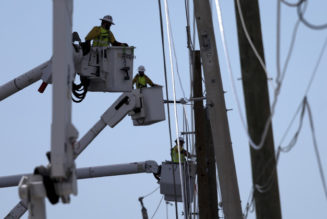
The decision points to biases within FEMA’s flood grant programs, which for years have favored wealthy or white areas.
“Sometimes the resources don’t go where they’re supposed to,” Morck said. “They’re supposed to give money where the need is.”
FEMA has allocated billions of dollars of flood-mitigation money using a racially inequitable system that has favored saving flood-prone houses in rich areas or in communities that are almost entirely white, using costly projects that elevate the homes above flood levels, an investigation by POLITICO’s E&E News shows.
The elevation grants have helped turn dozens of wealthy or overwhelmingly white areas into enclaves of climate resilience. The communities are seeing rising property values and economic stability, while much of the nation faces devastating effects of rising seas and intensifying floods.
Some of the country’s richest communities, from the Connecticut Gold Coast to the Florida Treasure Coast, have received millions of dollars to elevate waterfront houses. Those homeowners have profited from huge reductions in insurance costs and in some cases have sold newly elevated homes for hundreds of thousands of dollars more than their purchase price.
“There’s a terrible equity issue here,” said Philip Bedient, a flood expert and engineering professor at Rice University in Houston. In the Houston area, “a lot of houses have been lifted, but predominantly they have been lifted in the more affluent neighborhoods.”
Policies set by Congress, FEMA and state officials over three decades have made it nearly impossible for people who are Black or Hispanic, or who have limited income, to get federal elevation money in most states, E&E News found.
Because the money is restricted to people who own homes and who in most cases can pay tens of thousands of dollars for costs not covered by FEMA, Black and Hispanic people are penalized due to the nation’s huge racial and ethnic disparities in wealth and home ownership.
Federal lawmakers of both parties and FEMA have known for years about biases in the allocation of elevation funds but did nothing until August, when FEMA — in a tacit acknowledgment of the unfairness — took a small step to help disadvantaged communities win flood grants. The agency does not track the race or income of grant recipients.
FEMA is facing unprecedented scrutiny over equity in both its grant programs and the emergency aid it gives communities and individuals after disasters. The agency’s administrator, Deanne Criswell, said last year she ordered an “equity-based review of all of FEMA’s grant programs.”
E&E News analyzed FEMA databases containing tens of thousands of grant records, reviewed thousands of pages of state and local documents and property records, conducted more than two dozen interviews, and visited a half-dozen communities that have faced major flooding.
The analysis shows clear race- and wealth-based impacts in most of the 18 states that have received nearly all of the FEMA elevation funds.
In 12 of the 18 states, more than half of the FEMA elevation money has gone to communities that are wealthy or almost entirely white. In four states — Kentucky, Massachusetts, Ohio and West Virginia — more than 75 percent of the FEMA elevation money has gone to wealthy or overwhelmingly white communities. And in six states, at least 40 percent of the elevation money has gone to a single affluent or almost entirely white community.
“These programs have severe consequences for people of color, who have historically been marginalized. They’re too poor to qualify for help,” said Rep. Earl Blumenauer (D-Ore.), who has worked to reform FEMA grant programs.
FEMA Acting Associate Administrator for Resilience David Maurstad accepted E&E’s findings.
“I don’t disagree with the point that you’re making,” he said in an interview.
FEMA declined to explain its rejection of Wilson’s application beyond saying it “was prioritized below more competitive projects.” But the agency acknowledges that its flood programs are stained with equity problems.
“Do we need to see different outcomes? I think the answer is yes,” Maurstad said. “That’s why we’re looking at the programs to determine what we can do to reduce the barriers for homeowners in disadvantaged areas.”
‘A bonanza’ — if you’re rich
Federal elevation grants can change the trajectory of a family’s fortune.
Worth as much as $550,000, they are the triple crown of flood mitigation. Elevation projects increase the value of a home, protect it from flooding and destruction, and save recipients tens of thousands of dollars in insurance costs.
Some homeowners profit directly from the grants by selling elevated homes.
In Old Greenwich, Conn., one of the nation’s richest communities, a couple received $100,000 from FEMA in 2018 to help elevate the luxurious waterfront home they had bought 16 years earlier for $1.33 million.
The Colonial-style house, which was flooded during Superstorm Sandy in 2012, features four bedrooms, four bathrooms, two fireplaces, a swimming pool and faces Greenwich Cove near the Long Island Sound.
Two-and-a-half years after the elevation was finished, the couple sold the home for $3.17 million, town records show.
Price increase: $1.84 million.
There are hundreds of examples of people selling homes within a few years of getting FEMA money for elevation projects. Nothing prohibits homeowners from selling their house immediately after FEMA pays to improve it. And many factors in addition to an elevation project can increase a property’s value.
In Ormond Beach, Fla., a city on the Atlantic coast that’s 85 percent white, five of 10 homeowners who received FEMA grants sold their homes after they were elevated. One couple got $310,000 from FEMA in 2012 to elevate a five-bedroom house they had bought a year earlier for $200,000.
After the elevation, the couple sold the home for $520,000.
In Connecticut, E&E News obtained addresses of 62 homes that FEMA has paid millions to elevate in Old Greenwich and the affluent neighboring towns of Fairfield and Westport since the mid-2010s. Eleven have been sold.
Average sale price: $1.7 million.
“It was a bonanza,” said David Harmuth, a real estate agent in Old Greenwich. “For the homeowner, it was free money to lift their house.”
[flexi-common-toolbar] [flexi-form class=”flexi_form_style” title=”Submit to Flexi” name=”my_form” ajax=”true”][flexi-form-tag type=”post_title” class=”fl-input” title=”Title” value=”” required=”true”][flexi-form-tag type=”category” title=”Select category”][flexi-form-tag type=”tag” title=”Insert tag”][flexi-form-tag type=”article” class=”fl-textarea” title=”Description” ][flexi-form-tag type=”file” title=”Select file” required=”true”][flexi-form-tag type=”submit” name=”submit” value=”Submit Now”] [/flexi-form]









